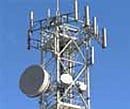
The new norms to be adopted by the Department of Telecom (DoT) to curb levels of radiation emitted from mobile towers are likely to reduce the health risk to humans by only a fraction.
As per the norms which are already in place, the radiation levels have to drop to 1/10th of the existing power density. As a result, the current density which is at 92 per watt per square metre (W/Sqm) will now have to be reduced to 0.92 W/Sqm. Similarly for the 900 Mhz GSM users the power density will be reduced from 48 W/Sqm to 0.48 W/Sqm.
However, if the recommendations made to DoT in 2010 by a professor of IIT Mumbai are anything to go by, the reduction in radiation levels decided upon by the Inter Ministerial Committee, falls far short of what is required.
In his report submitted to the DoT, Prof Girish Kumar of the Electrical Engineering Department, IIT Mumbai, recommended that radiation norms in India should conform those in some western nations, where they were less than 0.001 W/Sqm.
The report observes, “Many countries in the world have adopted much stricter maximum radiation density values of 0.001 to 0.24 W/ m2 (1/100th to 1/1000th of ICNIRP guidelines).”
The report had noted that India was following “very relaxed” radiation norms from mobile towers, “whereas serious health effects have been noted at as low as 0.0001 W/m2”.
On accord of this concern, the report recommended to the Centre to cut the cumulative power density to 0.1W/Sqm with “immediate effect”, and progressively bring down the power density to 0.01 W/Sqm.
“It must be noted that a few countries have even adopted 0.001 W/m² or lower, so our proposed recommendation is higher than these countries to keep it cost effective,” recommended the IIT report.
However, the new norms are higher than that recommended by the study.
As per the report of the Inter-Ministerial Committee, countries like Hungary (0.01W/Sqm), Switzerland (0.004W/Sqm), Italy (0.01 W/Sqm) and Australia (0.2W/Sqm) of power density.
The radiation levels are alarmingly high for Tier-1 cities like Bangalore which houses 23,000 mobile towers and shared by 10 service providers in the City. According to DoT officials, the stringent regulations will now have to be implemented with inspections of these towers and ensure that they are below the recommended radiation levels.
“We have the capacity to inspect 10 percent of the 23,000 mobile towers in a year. The biggest threat is from mobile towers that have a larger number of antennas (corresponding to the number of service provider using the tower),” said a DoT official.
